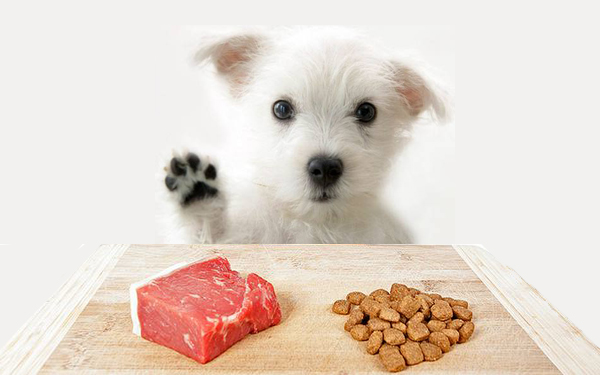Pet Owners
Are you looking for a great pet groomer? Search for a groomer close to you, read reviews and keep track of all your grooming appointments on https://www.petgroomerfinder.com.
Whether you are the owner of a dog, cat or even have both types of pets, you will know that because of their ancestry, they are both natural hunters. The domestication of dogs for thousands of years has not changed their digestive system which evolved from the wolf. Dogs are omnivores and because of their short intestinal tract, can consume and digest raw foods which include their prey and a mix of some grasses, berries, and vegetables.
On the other hand, cats are true carnivores and their digestive tract is designed to digest raw meat. In the wild, they hunt rodents and birds. Cats can’t tolerate carbohydrates or vegetables and they need amino acids that have Taurine, fatty acids, and essential vitamins and minerals only found in meat. These vital substances are believed to be diminished in the cooking process and a diet similar to what they had in nature is ideal, according to supporters of raw food diets for cats.
What does a raw diet for cats and dogs consist of?
The secret to a perfect raw food diet for pets is to balance it so that your beloved pet gets all the right nutrients. Pet owners choose many variations of the raw diet and some even go as far as believing that a bit is better than nothing, feeding their pets half raw and half dry.
Raw food for pets comes in more formulas than just the frozen variety that everyone has heard of. Freeze-dried and dehydrated formulas are also made from raw meats, and for dogs with added fruits, and vegetables. All that needs to be added is hot water before feeding time. These are great for people who like to travel with their pets and can’t rely on having a freezer around.
Contents of a raw food diet for cats
A raw food diet for your cat must include muscle meat, organ meat and ground bones from fish, chickens and other livestock. It is essential that these also contain eggs and other supplements in order to ensure that your cat has a complete and balanced diet. These can be prepared at home (let your vet recommend the right proportions) and can be frozen until needed. Another alternative is to buy from a reputable supplier.
For cats with certain health issues, especially if these affect their immune system, a raw food diet is not allowed.
Contents of a raw food diet for dogs
Typically, a raw food diet for dogs includes muscle meat, bones, organ meats, raw eggs, vegetables, fruit, and some dairy. High protein raw food diets need to include enough calcium and phosphorous, especially for puppies where a shortage can cause growth issues. Care must be taken that the raw diet product does not contain too much liver, this leads to increased vitamin A which can lead to toxicity.
Not all dogs can eat a raw food diet, especially those with kidney and liver problems, but your veterinarian is the best person to advise you.
What are the benefits of a raw food diet for cats and dogs?
Those who are against raw food diets argue that their biggest drawback is the pathogens found in raw food and how they will affect your pet. However, there are safe ways to handle foods in order to eliminate risks. Pathogens, like salmonella, are often also found in canned pet food.
Proponents of raw food diets for pets argue that there are far too many benefits compared to the risks. Cats have a short digestive tract that is acidic and food usually passes through their system without causing issues.
The benefits are:
- More nutrients which in turn offer the body immunity, better healing, and improved overall health
- Shinier coats and less shedding
- Cleaner teeth and fewer gum issues
- Prevents obesity
- Fewer allergies
- Flea infestations and hotspots are minimized
- Gastrointestinal problems are minimized, especially inflammatory bowel disease
The do’s and don’ts for a perfectly safe raw food diet
This is a guideline that will help you start your new kitten or puppy on a raw food diet, or help you to transition your older pet into it smoothly.
Do educate yourself before starting
Take the time to do some research and learn all about the nutritional requirements that your pet has before starting. Besides the nutritional value, you will also need to learn how to handle and store the food properly. Finally, find out everything you can about how to monitor the health of your pet.
Do learn about quality
Raw foods that are safe to feed your pets should be human-grade quality guaranteed. The diet needs to consist of bone, meat, fat, organs and fiber.
Do handle raw foods correctly
- If you are preparing the raw foods for your pet, they should be flash frozen immediately after packaging.
- Fresh meats should be served within 48 hours of being thawed.
- Food should only be left out for 15-20 minutes. If your pet hasn’t consumed it, it must be covered and refrigerated until feeding again.
- If the food has a foul smell it must be thrown away.
- All surfaces must be washed clean with soap and water before and after the food preparation.
- Prefer stainless steel or glass bowls and these must be washed and sanitized daily.
Do monitor your pet
You must monitor and keep a note of your pet’s stools, urination, appetite, energy levels, and thirst. Compare them to those from before switching to a raw food diet. Any changes must be mentioned to your veterinarian.
Adjustments that are normal are a decrease in thirst and stool size. Abnormal symptoms that must immediately be addressed are diarrhea, vomiting, lethargy, increased thirst, and urination.
You must always monitor your pets when they are eating whole raw bones.
Do make a safe switch
If your dog has been eating commercial foods, then a gradual switch needs to be made. The period needed to adjust to the new diet is one month and no whole bones should be fed to them in the first month. If you are feeding dry and raw foods, in the beginning, they should be placed in separate bowls.
Do have patience
Most pets make an easy transition from commercial to raw food diets, but some don’t. Cats are especially difficult to wean off kibble to raw. Whether you have a cat or dog, in the beginning, you may have to add some raw to the kibble and increase the raw over the course of a week, until your pet is only having raw food.
Do consult your vet or a holistic veterinarian
Your pet’s medical condition will determine the nutritional choices and supplements that will need to be added to the raw food diet. Follow the guidelines given by the veterinarian and monitor your pet’s health responsibly.
Do give your pet raw bones
Beef and pork bones should be cut to a suitable size for your pet and always fed under close observation. Bones help to strengthen the jaws and also clean the teeth. It is fine to feed your pet raw chicken and turkey bones because they do not splinter, unlike cooked bones.
Do keep your yard clean
With a raw diet, you will need to keep your yard spotlessly clean. This may take a bit extra time but will save on trips to the veterinarian.
Don’t mix raw food with commercial food
The difference in digestion rates of the two foods is different and this measure is only for the initial transitional period. Once you have weaned your pet from commercial food don’t ever mix the two again. Raw food requires 4-6 hours to digest, while kibble takes 8 – 10 hours. The difference in digestion times may create gas and other digestive issues.
If for some reason you want to give your pet both types of food, then the best way is to feed one type in the morning and the other in the evening.
Don’t feed frozen food to dogs (especially those less than 15 pounds)
If the raw food is completely frozen, the internal organs of a small dog can be damaged from the cold temperature of the food, especially if it is swallowed too fast. The best way to feed frozen raw food is to first thaw it completely. If you have a larger breed of dog that wants it frozen or partly thawed, then it’s fine. If your dog likes to drag his frozen food around, treating it like he would a bone, then it’s best to feed him outside.
Don’t overfeed
Most pets will eat as much food as you put out for them, even cats who like raw food. So be careful to stick to the right proportion for their age and weight.
Final say
Taking the nutritional, medical, and public health risks into consideration, a raw food diet for pets is increasingly supported with scientific evidence. Safer handling of these products by producers of raw pet food and by you will ensure that you and your pets can make it into an enjoyable experience which has many benefits for them.
Pet Owners
Are you looking for a great pet groomer? Search for a groomer close to you, read reviews and keep track of all your grooming appointments on https://www.petgroomerfinder.com.

